 |
 |
Our enthusiastic and extremely knowledgeable perennials team is here to answer your questions and help you choose the best perennials for your situation. There’s always something in bloom for sun, shade, butterflies, birds or deer resistance as well as a variety of bulbs for your space.
Stroll through our time-tested favorites and introduce yourself to the newest varieties. We garden with perennials too; we love them and it shows!
|
29 found, showing page 1 of 2

Drooping blooms with white outer petals and yellow inner accents. Native and deer resistant. USDA 3-8
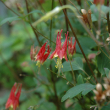
Unique, drooping flowers emerge in late spring. Bright-red outer petals contrasted by yellow filaments. USDA 3-8
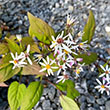
Height: 30 inches
Spread: 30 inches
Sunlight: partial shade full shade
Hardiness Zone: 3a
Other Names: syn. Aster divaricatus, White Star Aster
Description:
A profusion of airy white flowers with gold to red eyes, over a mound of small green leaves; thrives in shade and tolerates dry conditions; water the root zone instead of from the top to reduce fungal disease; water regularly to encourage more blooms
Ornamental Features:
White Wood Aster has masses of beautiful white flat-top daisy flowers with gold eyes at the ends of the stems from mid to late summer, which are most effective when planted in groupings. Its small heart-shaped leaves remain light green in color throughout the season.
Landscape Attributes:
White Wood Aster is an herbaceous perennial with an upright spreading habit of growth. It brings an extremely fine and delicate texture to the garden composition and should be used to full effect.
This is a relatively low maintenance plant, and is best cleaned up in early spring before it resumes active growth for the season. It is a good choice for attracting butterflies to your yard, but is not particularly attractive to deer who tend to leave it alone in favor of tastier treats. Gardeners should be aware of the following characteristic(s) that may warrant special consideration: Disease
White Wood Aster is recommended for the following landscape applications:
- Mass Planting
- Rock/Alpine Gardens
- Border Edging
- General Garden Use
- Groundcover
- Naturalizing And Woodland Gardens
- Container Planting
Planting & Growing:
White Wood Aster will grow to be about 30 inches tall at maturity, with a spread of 30 inches. Its foliage tends to remain dense right to the ground, not requiring facer plants in front. It grows at a medium rate, and under ideal conditions can be expected to live for approximately 4 years. As an herbaceous perennial, this plant will usually die back to the crown each winter, and will regrow from the base each spring. Be careful not to disturb the crown in late winter when it may not be readily seen!
This plant does best in partial shade to shade. It prefers to grow in average to dry locations, and dislikes excessive moisture. It is considered to be drought-tolerant, and thus makes an ideal choice for a low-water garden or xeriscape application. This plant should not require much in the way of fertilizing once established, although it may appreciate a shot of general-purpose fertilizer from time to time early in the growing season. It is not particular as to soil type or pH. It is somewhat tolerant of urban pollution. This species is native to parts of North America. It can be propagated by division.
White Wood Aster is a fine choice for the garden, but it is also a good selection for planting in outdoor pots and containers. With its upright habit of growth, it is best suited for use as a 'thriller' in the 'spiller-thriller-filler' container combination; plant it near the center of the pot, surrounded by smaller plants and those that spill over the edges. It is even sizeable enough that it can be grown alone in a suitable container. Note that when growing plants in outdoor containers and baskets, they may require more frequent waterings than they would in the yard or garden.

Ruffled petals with sunset pink and coral tones. Black walnut tolerant. USDA 3-9
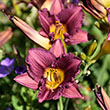
Ruffled purple blooms with yellow throats. Rebloomer. USDA 3-9
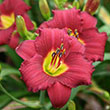
Plant Height: 12 inches
Flower Height: 18 inches
Spacing: 14 inches
Sunlight: full sun, partial shade
Hardiness Zone: 2b
Description:
A reblooming variety with a compact, vigorous habit; fragrant, ruffled burgundy flowers with chartreuse-gold throats rise above mounds of arching green foliage; an elegant addition to borders, beds and containers; low maintenance and easy to grow
Ornamental Features:
Pardon Me Daylily features bold fragrant burgundy trumpet-shaped flowers with chartreuse throats at the ends of the stems from early to late summer. The flowers are excellent for cutting. Its grassy leaves remain green in color throughout the season.
Landscape Attributes:
Pardon Me Daylily is an herbaceous perennial with tall flower stalks held atop a low mound of foliage. It brings an extremely fine and delicate texture to the garden composition and should be used to full effect.
This is a relatively low maintenance plant, and is best cleaned up in early spring before it resumes active growth for the season. It is a good choice for attracting butterflies to your yard. It has no significant negative characteristics.
Pardon Me Daylily is recommended for the following landscape applications:
- Mass Planting
- Border Edging
- General Garden Use
- Groundcover
- Container Planting
Planting & Growing:
Pardon Me Daylily will grow to be about 12 inches tall at maturity extending to 18 inches tall with the flowers, with a spread of 18 inches. When grown in masses or used as a bedding plant, individual plants should be spaced approximately 14 inches apart. Its foliage tends to remain dense right to the ground, not requiring facer plants in front. It grows at a medium rate, and under ideal conditions can be expected to live for approximately 10 years. As an herbaceous perennial, this plant will usually die back to the crown each winter, and will regrow from the base each spring. Be careful not to disturb the crown in late winter when it may not be readily seen!
This plant does best in full sun to partial shade. It is very adaptable to both dry and moist locations, and should do just fine under typical garden conditions. It is not particular as to soil type or pH. It is highly tolerant of urban pollution and will even thrive in inner city environments. This particular variety is an interspecific hybrid. It can be propagated by division; however, as a cultivated variety, be aware that it may be subject to certain restrictions or prohibitions on propagation.
Pardon Me Daylily is a fine choice for the garden, but it is also a good selection for planting in outdoor pots and containers. It is often used as a 'filler' in the 'spiller-thriller-filler' container combination, providing a mass of flowers against which the larger thriller plants stand out. Note that when growing plants in outdoor containers and baskets, they may require more frequent waterings than they would in the yard or garden.
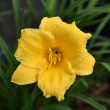
Plant Height: 12 inches
Flower Height: 18 inches
Spacing: 14 inches
Sunlight: full sun, partial shade
Hardiness Zone: 2b
Other Names: Stella D'Oro Daylily
Description:
An early bloomer with a compact habit; fragrant, rich golden yellow, ruffled flowers stand out against green arching foliage; reblooming in the late summer months; easy to grow, perfect for borders, beds and containers; drought tolerant once established
Ornamental Features:
Stella de Oro Daylily features bold gold trumpet-shaped flowers at the ends of the stems from early summer to early fall. The flowers are excellent for cutting. Its grassy leaves remain green in color throughout the season.
Landscape Attributes:
Stella de Oro Daylily is an herbaceous perennial with a shapely form and gracefully arching foliage. It brings an extremely fine and delicate texture to the garden composition and should be used to full effect.
This is a relatively low maintenance plant, and is best cleaned up in early spring before it resumes active growth for the season. It is a good choice for attracting butterflies to your yard. It has no significant negative characteristics.
Stella de Oro Daylily is recommended for the following landscape applications:
- Mass Planting
- Border Edging
- General Garden Use
- Groundcover
- Container Planting
Planting & Growing:
Stella de Oro Daylily will grow to be about 12 inches tall at maturity extending to 18 inches tall with the flowers, with a spread of 18 inches. When grown in masses or used as a bedding plant, individual plants should be spaced approximately 14 inches apart. Its foliage tends to remain dense right to the ground, not requiring facer plants in front. It grows at a medium rate, and under ideal conditions can be expected to live for approximately 10 years. As an herbaceous perennial, this plant will usually die back to the crown each winter, and will regrow from the base each spring. Be careful not to disturb the crown in late winter when it may not be readily seen!
This plant does best in full sun to partial shade. It is very adaptable to both dry and moist locations, and should do just fine under typical garden conditions. It is not particular as to soil type or pH. It is highly tolerant of urban pollution and will even thrive in inner city environments. This particular variety is an interspecific hybrid. It can be propagated by division; however, as a cultivated variety, be aware that it may be subject to certain restrictions or prohibitions on propagation.
Stella de Oro Daylily is a fine choice for the garden, but it is also a good selection for planting in outdoor pots and containers. It is often used as a 'filler' in the 'spiller-thriller-filler' container combination, providing a mass of flowers against which the thriller plants stand out. Note that when growing plants in outdoor containers and baskets, they may require more frequent waterings than they would in the yard or garden.
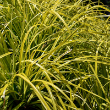
Height: 16 inches
Spread: 16 inches
Sunlight: full sun, partial shade, full shade
Hardiness Zone: 4b
Other Names: C. hachijoensis
Group/Class: EverColor Series
Description:
A vigorous, mound forming evergreen plant with striking lime green emerging foliage that matures to yellow-gold; makes quite a statement as a container plant, an accent in the border, or as a mass groundcover
Ornamental Features:
EverColor Everillo Japanese Sedge is primarily valued in the garden for its cascading habit of growth. Its attractive grassy leaves emerge lime green in spring, turning yellow in color. The foliage often turns gold in fall.
Landscape Attributes:
EverColor Everillo Japanese Sedge is an herbaceous evergreen perennial grass with a shapely form and gracefully arching stems. It brings an extremely fine and delicate texture to the garden composition and should be used to full effect.
This is a relatively low maintenance plant, and is best cleaned up in early spring before it resumes active growth for the season. It has no significant negative characteristics.
EverColor Everillo Japanese Sedge is recommended for the following landscape applications:
- Mass Planting
- Border Edging
- General Garden Use
- Groundcover
- Naturalizing And Woodland Gardens
- Container Planting
Planting & Growing:
EverColor Everillo Japanese Sedge will grow to be about 16 inches tall at maturity, with a spread of 16 inches. Its foliage tends to remain dense right to the ground, not requiring facer plants in front. It grows at a medium rate, and under ideal conditions can be expected to live for approximately 10 years. As an evegreen perennial, this plant will typically keep its form and foliage year-round.
This plant performs well in both full sun and full shade. It prefers to grow in average to moist conditions, and shouldn't be allowed to dry out. It is not particular as to soil type or pH. It is somewhat tolerant of urban pollution. Consider applying a thick mulch around the root zone in both summer and winter to conserve soil moisture and protect it in exposed locations or colder microclimates. This is a selected variety of a species not originally from North America. It can be propagated by division; however, as a cultivated variety, be aware that it may be subject to certain restrictions or prohibitions on propagation.
EverColor Everillo Japanese Sedge is a fine choice for the garden, but it is also a good selection for planting in outdoor pots and containers. It is often used as a 'filler' in the 'spiller-thriller-filler' container combination, providing a canvas of foliage against which the thriller plants stand out. Note that when growing plants in outdoor containers and baskets, they may require more frequent waterings than they would in the yard or garden.
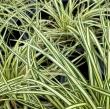
'Evergold' Japanese Sedge | Bright creamy yellow-striped, narrow leaves makes this a wonderful accent. Variegated. Evergreen. Tolerates moist soils. Naturalizing. USDA 5-9
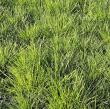
Rich-green fronds have a dense, upright growth habit. White, puffy plumes in late summer. USDA 4-9
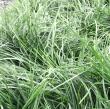
Cool season semi-evergreen ornamental grass. Deep, dark green foliage and airy, golden yellow flowers. USDA 4-9
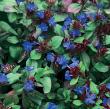
Height: 12 inches
Spread: 18 inches
Sunlight: full sun, partial shade
Hardiness Zone: 4b
Other Names: Leadwort
Description:
Excellent groundcover with clusters of the truest blue flowers in late summer; foliage turns a nice bronzy-red color in fall; flowers resemble that of woodland phlox, and the red calyces add a wonderful color contrast
Ornamental Features:
Plumbago features showy clusters of blue star-shaped flowers with brick red calyces at the ends of the stems from late summer to early fall. Its glossy oval leaves are green in color. As an added bonus, the foliage turns a gorgeous red in the fall.
Landscape Attributes:
Plumbago is an herbaceous perennial with an upright spreading habit of growth. Its medium texture blends into the garden, but can always be balanced by a couple of finer or coarser plants for an effective composition.
This is a relatively low maintenance plant, and is best cleaned up in early spring before it resumes active growth for the season. It is a good choice for attracting bees and butterflies to your yard. It has no significant negative characteristics.
Plumbago is recommended for the following landscape applications:
- Mass Planting
- Rock/Alpine Gardens
- Border Edging
- General Garden Use
- Groundcover
- Naturalizing And Woodland Gardens
- Planting & Growing
Plumbago will grow to be about 10 inches tall at maturity, with a spread of 18 inches. Its foliage tends to remain low and dense right to the ground. It grows at a medium rate, and under ideal conditions can be expected to live for approximately 8 years. As an herbaceous perennial, this plant will usually die back to the crown each winter, and will regrow from the base each spring. Be careful not to disturb the crown in late winter when it may not be readily seen!
This plant does best in full sun to partial shade. It does best in average to evenly moist conditions, but will not tolerate standing water. It is not particular as to soil type or pH. It is somewhat tolerant of urban pollution. Consider covering it with a thick layer of mulch in winter to protect it in exposed locations or colder microclimates. This species is not originally from North America. It can be propagated by division.
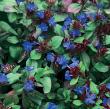
Deep blue flowers. In early fall, leaves change to a vivid mahogany red color. Growing in sun or shade. Wide range of soil types. Long-lived groundcover. USDA 5-9
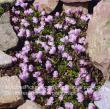
Lilac blooms. Dense groundcover. Light foot traffic. USDA 5-9
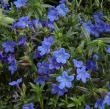
Bright purpley blue blooms. Deep green foliage. Groundcover. USDA 6-8
29 found, showing page 1 of 2








